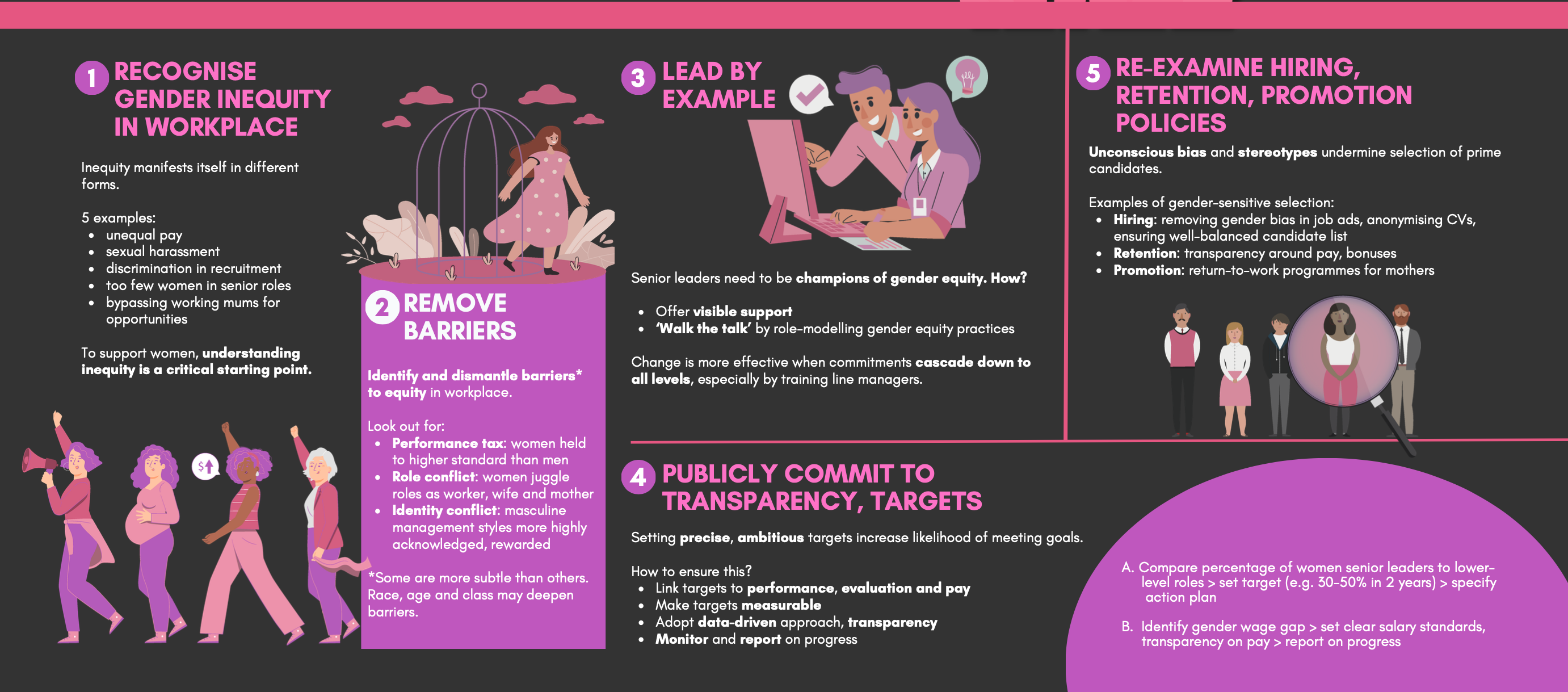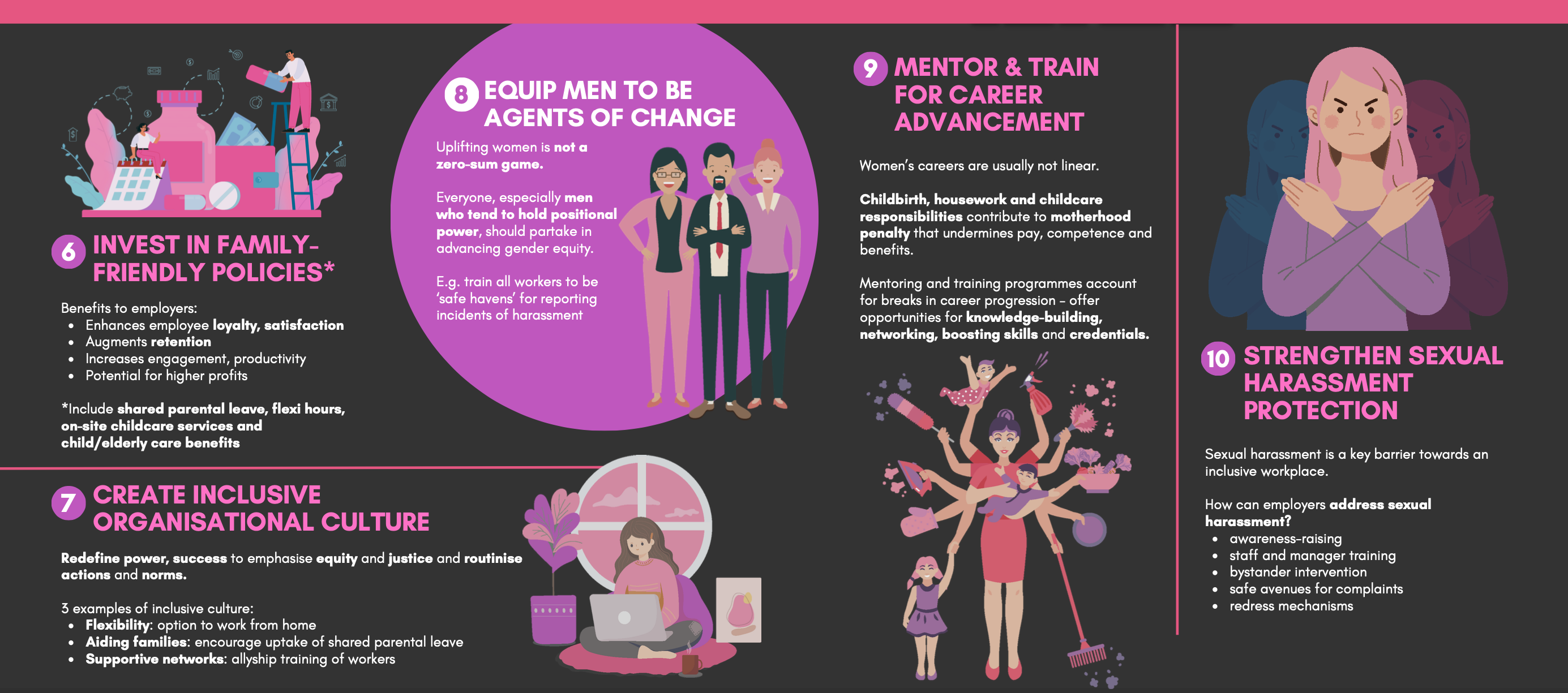
Most workplaces are designed by men for men.
The result? Women must overcome more hurdles to achieve the same level of success
- Women outnumber men in education and score better. But labour force participation rates remain lower than men
- Covid-19 hit women harder – employment outcomes still lagging men’s
Are Malaysian workplaces not inclusive?

Why should bosses care about gender equity?
Follow the money – there’s strong business case for change.
5 ways gender equity boosts business outcomes:
- Raises financial performance
- Improves employee engagement, facilitates inclusive workplace culture
- Creates inventive decision-making, reduces risks and boosts ethics
- Attracts, retains talent
- Strengthens branding, brings firms closer to customer base

Why should organisations be leaders of change in gender equity?
- Malaysia set target of 30% women on boards, senior leadership
- In 2022, Malaysia boasted highest percentage of women board members (26%) in Asia, compared with global average of 19.7%
- More global firms embracing, publicising diversity and inclusion policies
Malaysian companies must catch up and make workplace more inclusive.


1. Recognise gender inequity in workplace
Inequity manifests itself in different forms.
5 examples:
- unequal pay
- sexual harassment
- discrimination in recruitment
- too few women in senior roles
- bypassing working mums for opportunities
To support women, understanding inequity is a critical starting point.

2. Remove barriers
Identify and dismantle barriers* to equity in workplace.
Look out for:
- Performance tax: women held to higher standard than men
- Role conflict: women juggle roles as worker, wife and mother
- Identity conflict: masculine management styles more highly acknowledged, rewarded
*Some are more subtle than others. Race, age and class may deepen barriers.

3. Lead by example
Senior leaders need to be champions of gender equity. How?
- Offer visible support
- ‘Walk the talk’ by role-modelling gender equity practices
Change is more effective when commitments cascade down to all levels, especially training line managers.

4. Publicly commit to transparency, targets
Setting precise, ambitious targets increase likelihood of meeting goals.
How to ensure this?
- Link targets to performance evaluation and pay
- Make targets measurable
- Adopt data-driven approach, transparency
- Monitor and report on progressi
A. Compare percentage of women senior leaders to lower-level roles – set target (e.g. 30-50% in 2 years) – specify action plan
B. Identify gender wage gap – set clear salary standards, transparency on pay – report on progress
Notes
iFrancke, A. (2019). Create a gender-balanced workplace. Penguin.

5. Re-examine hiring, retention, promotion policies
Unconscious bias and stereotypes undermine selection of prime candidates.
Examples of gender-sensitive selection:
- Hiring: removing gender bias in job ads, anonymising CVs, ensuring well-balanced candidate list
- Retention: transparency around pay, bonuses
- Promotion: return-to-work programmes for mothers

6. Invest in family-friendly policies*
Benefits to employers:
- Enhances employee loyalty, satisfaction
- Augments retention
- Increases engagement, productivity
- Potential for higher profits
*Include shared parental leave, flexi hours, on-site childcare services and child/elderly care benefits

7. Create inclusive organisational culture
Redefine power, success to emphasise equity and justice and routinise actions and norms.
3 examples of inclusive culture:
- Flexibility: option to work from home
- Aiding families: encourage uptake of shared parental leave
- Supportive networks: allyship training of workers

8. Equip men to be agents of change
Uplifting women is not a zero-sum game
Everyone, especially men who tend to hold positional power, should partake in advancing gender equity.
E.g. train all workers to be ‘safe havens’ for reporting incidents of harassmentii

9. Mentor & train for career advancement
Women’s careers are usually not linear.
Childbirth, housework and childcare responsibilities contribute to motherhood penalty that undermines pay, competence and benefits.
Mentoring and training programmes account for breaks in career progression – offer opportunities for knowledge-building, networking, boosting skills and credentials.

10. Strengthen sexual harassment protection
Sexual harassment is a key barrier towards an inclusive workplace.
How can employers address sexual harassment?
- awareness-raising
- staff and manager training
- bystander intervention
- safe avenues for complaints
- redress mechanisms








